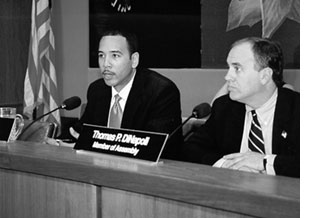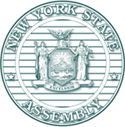|
New York State Assembly, Albany, New York 12248 |
||||
|
||||

|
|
Legislative
Commission on Critical Transportation Choices |
||
|
|
||||
|
||||||||||||||
|
|
||||||||||||||
|
Sheldon Silver, Speaker December 2002 |
|
|
|||||
|
|
Exhaust Control Devices The Metropolitan Transportation Authority (MTA) in New York City has committed to retrofitting all of its diesel buses with advanced particulate controls by the end of 2003. The Department of Environmental Conservation is working with the MTA to evaluate the use of particulate filters or catalyzed particulate filters (CRT) in conjunction with ultra low sulfur diesel fuel for long haul vehicles. The trap oxidizer or particulate filter can reduce particulate matter emissions by 80 to greater than 90 percent, carbon monoxide and hydrocarbon emissions by greater than 90 percent, and toxic hydrocarbon emissions up to 90 percent. The Department of Transportation (DOT) is working with Cummings Incorporated, one of the largest engine manufacturers in New York State, to test an alternate emissions technology that would work more beneficially for shorter trips. A diesel oxidation catalyst (DOC) is not as dependent on constant engine temperature to be effective. It can be used with ultra low sulfur diesel fuel to achieve significant benefits in emissions reductions — less than CRT but still significant. DOCs are capable of reducing particulate matter emissions 20 to 50 percent carbon monoxide and hydrocarbon emissions greater than 90 percent, and toxic hydrocarbon emissions greater than 70 percent. In some applications, catalyst and trap technologies can be combined to provide even greater control and can be used in combination with engine management techniques, to provide significant control of both particulates and NOx. Emerging technologies for the reduction of oxides of nitrogen or NOx are: lean NOx catalysts; exhaust gas recirculation (EGR); and, selective catalytic reduction (SGR). Lean NOx catalysts can reduce NOx emissions 5 to 15 percent. EGR is capable of reducing NOx emissions greater than 40 percent. Advanced Vehicle Technologies The New York State Energy Research and Development Authority (NYSERDA) Advanced Vehicle Technology Development Program supports New York firms in developing advanced energy and pollution reduction technologies for national and international markets, emphasizing technologies that have the potential to meet the State’s needs. About $2 million is provided annually to cost-share projects. The New York Power Authority also implements R&D programs with a focus on AFVs. NYSERDA is sponsoring the development of duel fuel technology which is an innovative approach that enables a diesel engine to operate predominantly on natural gas and at the same time uses a small amount of liquid diesel fuel. Advanced Fuel Technologies NOCO Energy, a New York State petroleum business, has received a grant from NYSERDA to do a feasibility study of the operability of biodiesel blend with low sulfur diesel currently available. Biodiesel is a fuel made primarily from the oils and fats of plants. Although it can be used as a straight replacement to diesel, it can also be blended with regular diesel fuel. The blend of biodiesel can be as low as 20 percent biodiesel, 80 percent diesel. When used as a replacement fuel for diesel or blending component or additive for premium diesel, biodiesel substantially reduces harmful emissions without sacrificing performance and efficiency. Truck Idling EPA provided a grant to Consolidated Edison and the Clean Air Communities (CAC), a non-profit enterprise committed to implementing air pollution reduction and energy efficiency strategies in low-income New York City communities that are disproportionately affected by air pollution, to establish the Hunts Point Market Truck Stop Electrification Project (TSE Project), the first operational anti-idling advanced electrification project in the country. The project consists of installing 30 electrified bays at the Market, one of the largest produce and meat markets in the world, to reduce the impact of diesel exhaust. Trucks would be able to use pioneering technology to provide electricity to run air conditioning and heat, keep the engine warm, power appliances, and maintain battery charge. The TSE Project is expected to eliminate more than 2,300 tons of air pollution annually in the Hunts Point residential community. |
|
|
|
|
|
|
||
According to the Natural Resources Defense Council (NRDC) report "No Breathing in the Aisles" ( January 2001) children are the most susceptible to health effects of diesel exhaust exposure as a result of the child’s developing body and lungs, narrower airways, faster metabolism and faster breathing rate. Children make up only 25 percent of the population but represent 40 percent of all asthma cases. In a unique study by the Mt. Sinai School of Medicine in 1999, researchers found that low-income, predominantly minority neighborhoods pose a far greater risk for children than more affluent communities. Rates of hospitalization for asthma incidence was 21 times higher for low-income areas. |
||
|
|
||
In 1997, EPA again promulgated new air standards for ground level ozone (smog) and particulates (soot). Starting in 2004, federal emission standards for new heavy-duty trucks and buses will require a 50 percent reduction in tailpipe emissions of nitrogen oxides (NOx), particulate matter (PM), and HCs which cause soot and smog. A 95 percent reduction of NOx and 90 percent reduction of PM emissions will be required in 2007. These 2007 standards will require new pollution control devices, and will follow the mid-2006 introduction of low-sulfur diesel fuel (capped at 15 parts-per-million) throughout the nation. |
||
|
|
||
|

|
Assemblyman Ruben Diaz, Jr. (left) and Assemblyman Thomas DiNapoli hear testimony at a public hearing sponsored by the Commission on May 8, 2002, in Albany. |
|
|
|
|
|
|
|

|
|
New York State Assembly [ Welcome Page ] [ Commission Updates ] |